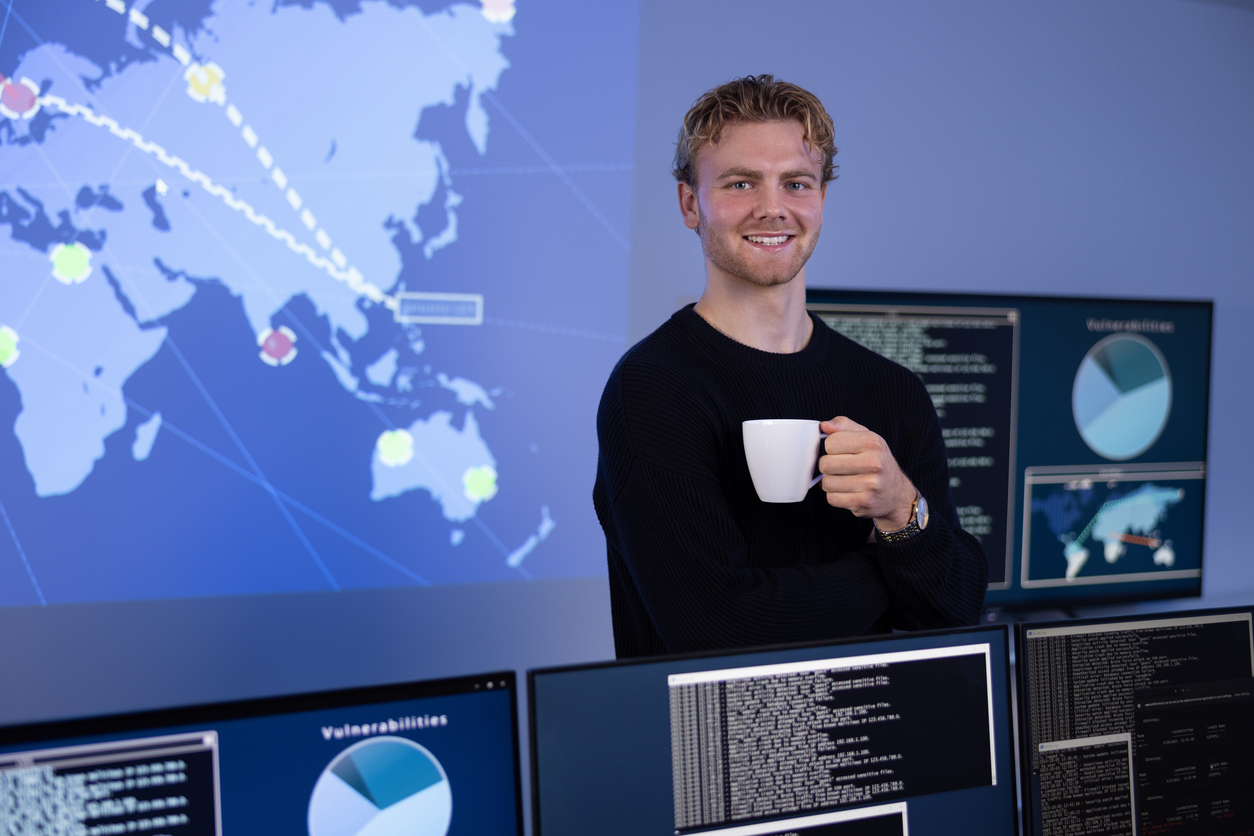In this post, you'll get an overview of what cybersecurity means today, why it's important, what cyber threats you need to be aware of, and six trends that will be in focus in 2026.
Table of Contents
Why is cybersecurity important?
What's the reality regarding third parties, PII, and AI in relation to cybersecurity?

What is cybersecurity?
Cybersecurity is about protecting people, systems, networks, applications, and data against cyberattacks through a combination of technology, processes, and policies. It's about preventing, detecting, and managing digital threats that can lead to data theft, extortion, operational disruptions, or in the worst case, societal disturbances.
A modern cybersecurity strategy is a central part of organizations' risk management, especially when it comes to managing cyber risks. The number of attacks is increasing and they are becoming more sophisticated, while increasingly being driven by new technologies such as generative AI, cloud solutions, IoT, and distributed work methods. This makes cybersecurity a necessity for businesses, the public sector, and individuals.
Cisco defines cybersecurity as protecting systems, networks, and programs from digital attacks. IBM emphasizes that people, technology, and processes must interact to build a secure digital environment.
Different types of cybersecurity
To build a strong defense, several layers of protection are required:
- Network security – stop unauthorized access to networks
- Endpoint security – protect computers, mobiles, servers, etc.
- Application security (AppSec) – plug vulnerabilities in software
- Cloud security – secure data and applications in cloud and multi-cloud environments
- Identity security (IAM, MFA, Zero Trust) – control who has access to what
- Information security (InfoSec) – protect both digital and physical information
- Critical infrastructure security – defense of society-bearing systems
- AI security – protect both AI systems and against AI-driven attacks
Why is cybersecurity important?
Cyberattacks can lead to identity theft, data breaches, financial losses, regulatory fines, and damaged trust. Attacks on critical infrastructure such as hospitals, energy supply, and banks can have very serious consequences for the entire society.
The global cost of cybercrime is expected to reach 10.5 trillion USD annually by 2025, and the average cost of a data breach is about 4.88 million USD. There is also a global shortage of cybersecurity experts, which according to the World Economic Forum could amount to about 85 million people by 2030.
Common cyber threats
The most common threats today include:
- Ransomware – locks files or systems and demands ransom
- Malware – malicious software that provides unauthorized access or damages systems
- Phishing – fake emails or messages that trick users into giving away data
- Identity attacks – stolen or misused user credentials, often via phishing or theft of login/authentication details
- Insider threats – errors or misuse from employees, partners, or hijacked accounts
- AI-driven attacks – e.g., prompt injection (malicious instructions in user input) or AI-generated phishing campaigns
- DDoS attacks – overloading systems to knock out services
- Social engineering – manipulation of people rather than technology
- Cryptojacking – hijacking computer resources to mine cryptocurrencies
9% of the surveyed organizations were affected by security incidents caused by third parties during 2020.
24% of the surveyed organizations were affected by security incidents caused by third parties during 2024.
What's the reality regarding third parties, PII, and AI in relation to cybersecurity?
Familiarize yourself with how others think and feel. It makes it easier to understand what others are investing in and what their cybersecurity challenges say about your everyday life:
- 44% of organizations conduct over 100 third-party assessments each year, but only 4% of organizations have high confidence that their third-party surveys/evaluations truly correspond to the actual third-party risk.
- Nearly 4 out of 10 companies use multiple surveys for different risk domains and send an average of 55 surveys to third-party suppliers.
- 57% state that operational and financial risk are the most important factors when monitoring third-party risks.
- 24% of organizations were affected by security incidents caused by third parties during 2024, an increase from 9% in 2020.
- 40% of cyber insurance claims involve a third party in connection with the breach
- Nearly half of all data breaches in 2024 involved personally identifiable information (PII), making it the most common type of stolen or compromised data.
- Organizations using AI and automation in security detected and stopped data breaches nearly 100 days faster on average than those not using these technologies.
- 89% of security executives who participated in the survey believe that AI and machine learning are important for improving their security posture.
- 47% of organizations prioritize upskilling their existing staff in AI-specific skills.
- 78% of AI users bring their own AI tools to work (BYOAI).
6 future cybersecurity trends
More and more companies are forced to deal with ransomware as a reality in their operations. Nearly half now have a policy that allows for paying ransoms, and for many it has become a recurring budget item.
This is not surprising when more than half of all organizations have been affected in the past year. Industries particularly vulnerable to ransomware include healthcare, financial services, manufacturing, technology, and energy.
How will the reality of cybersecurity change? What will you need to invest in right now to be able to meet the future?
1. AI takes its place in the defense line
Artificial intelligence is becoming an integral part of security work. Next-generation platforms are built on AI-driven agents that can independently isolate compromised systems and initiate countermeasures. Examples of what AI is used for:
- Automated response: isolate systems and stop attacks without human intervention
- Advanced attacks: generate hyperpersonalized phishing attempts and malicious code
- Anomaly detection: build baselines for normal behavior of users and devices to detect insider threats
The race between attackers and defenders makes innovation in defense algorithms and collaboration on threat intelligence crucial.
2. Zero Trust becomes the norm in the cloud
Zero Trust means that no user or device receives implicit trust. All access is continuously verified and limited to the minimum possible level.
This becomes particularly important as organizations move to hybrid clouds and multi-cloud environments. We see three clear developments:
- Built-in security principles: continuous authentication, least possible access, and microsegmentation in cloud services
- Dynamic policies: adapted in real-time based on device health status, geographic location, and risk level
- SaaS-specific gateways: solutions for cloud-based applications that provide control over sessions and can detect anomalies in user behavior
3. Regulations make compliance a competitive issue
Regulations are becoming increasingly comprehensive. GDPR is well established and sets the framework for how personal data may be processed. The NIS2 directive tightens requirements on how socially critical and important operations must work with cybersecurity, including through incident reporting and clear security measures.
DORA (Digital Operational Resilience Act) is specifically aimed at the financial sector and focuses on operational resilience and management of IT-related risks. At the same time, the EU's Cyber Resilience Act is coming, which sets new requirements that products with digital elements must be secure throughout their lifecycle. Three areas to keep track of:
- AI and transparency: regulations require organizations to be able to show how algorithms make decisions and handle bias
- Automated compliance: With the help of AI, RPA, and platforms like Softadmin®, organizations can continuously review logs and data flows and automatically flag deviations
- Business value of compliance: organizations that can demonstrate high security win in procurements and strengthen their brand
4. Automation and orchestration streamline security operations
Pressure on security teams is increasing, making automation critical. SOAR platforms (Security Orchestration, Automation and Response) are used to handle incidents faster and more efficiently. The trend can be described in three parts:
- SOAR and threat intelligence: incidents can be resolved via conversational interfaces and automated runbooks
- Digital twins: simulate attacks in a realistic environment and improve incident response plans
- FinOps meets SecOps: resources are automatically allocated where they deliver the most value without breaking the budget
5. IoT, 5G, and edge introduce new challenges
As billions of devices connect to 5G, the attack surface grows dramatically. New solutions are required to address this:
- Distributed firewalls and lightweight agents: protect edge devices like self-driving cars and smart factories
- Identity management: By using hardware-based certificates and a decentralized PKI (Public Key Infrastructure—a framework for digital certificates and encryption), it becomes harder for attackers to hijack identities or take over devices
- Edge AI: Analysis happens directly on devices such as cameras, routers, and sensors, instead of sending data to the cloud. This enables real-time anomaly detection with shorter response times and less network load
6. Security culture at every level
Technical solutions are not enough. The human factor is a crucial part of security. Organizations are moving from annual trainings to more continuous initiatives:
- Phishing simulations: regular tests tailored to users’ needs
- Microlearning: short modules tied to real-world situations
- Board level: cybersecurity is integrated into risk reports and financial decision-making materials
- A safe culture within security teams: when employees feel safe reporting issues, both detection rates and innovation increase.
Multisoft, Softadmin®, cybersecurity, and AI
Softadmin® is one of the market’s most efficient low-code platforms. It is built on standardized components that combine high flexibility with the ability to scale as your operations grow. You choose the features you need, while the technical building blocks are always standardized and proven. This allows us to jointly build a tailored solution for you—quickly.
AI is used to make the systems smarter and more useful—for example by comparing data, answering questions based on your information sources, recognizing images, analyzing and classifying documents, or generating summaries and translations.
Multisoft has access to the full Microsoft Azure AI Services and Azure OpenAI, enabling AI capabilities to be embedded directly into your processes and delivered ready to use in Softadmin® systems.
Because Softadmin® is built from secure standard components, with AI used for configuration, you can trust that the overall solution is always secure.




